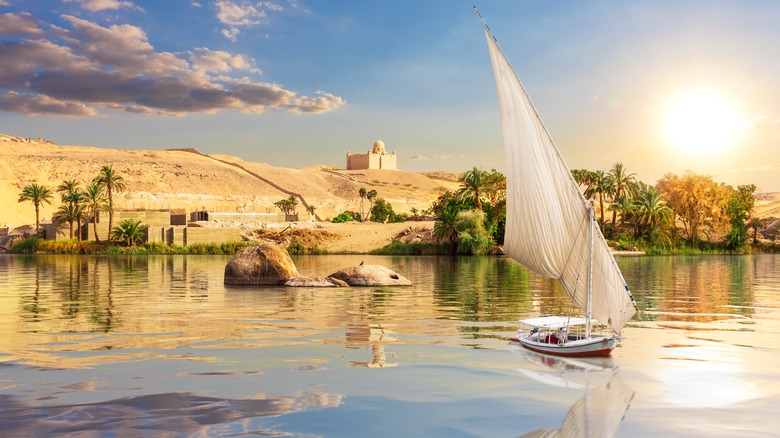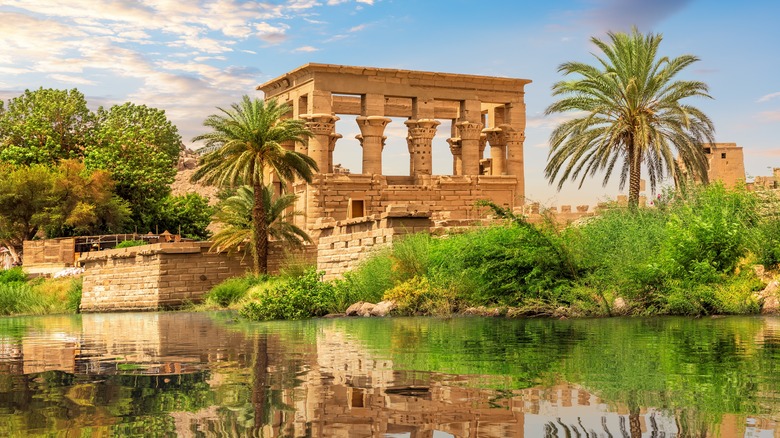Cruise The Nile In The Way The Pharaoh's Did Aboard One Of These Traditional Sailboats
Ruling the most powerful civilization on earth, Egyptian pharaohs would glide past the same braying hippos and reed-occluded crocodiles that ridge the Nile today. The heat still beats over the opulent residue of the ancient empire, best explored on a small tour down the mighty river. Bypass the modern cruises and their flaws and opt instead to glide south on a traditional felucca. Two-masted lateen sail crafts traditionally strung from reed or papyrus, feluccas carried emperors, tradesmen, and travelers through north Africa for millennia.
Sail in royal style between the ancient cities of Aswan and Luxor, traveling slowly past the myriad landscapes and isolated relics of the Nile basin. Unlike their ancestral counterparts, modern felucca tours come with toilets and hot running water, and local meals are prepared onboard, making a 2-night cruise under Saharan stars a comfortable experience. Tours set sail a short distance from Cairo, sidestepping the Egyptian capital's chaotic city center and plunging travelers straight into the tranquil heartland.
Glide past history in Aswan, Egypt
In Aswan, golden walls stand sentinel over the jutting reeds of the Nile riverbank, carefully carved homages to ancient gods. Taking the felucca route down to the southerly Egyptian city, you'll already have traversed the watery route that linked the Mediterranean titans of Egypt, Greece, and Rome with the African empires that sprawled south from Sudan. The cultural intersection is omnipresent — the regional language is spliced between Swahili and ancient Egyptian and wild Nubian jasmine scents the air. The vestiges of grandeur visible from felucca-edge offer travelers a glimpse at the worship rituals and burial practices that remained occluded from the global eye under Sahara sands for centuries.
Stretch your legs after a sailing stretch and explore the tourist-friendly city on foot. Learn about the confluence of Egyptian and Greco-Roman culture and architectural style under the Ptolemaic dynasty at the Temple of Isis. One of the last outposts of Egyptian paganism, preserving the ancient ways until the 6th century AD, the temple marks the spot where the goddess Isis found the heart of her dismembered husband.
Next, visit the vast granite Unfinished Obelisk. Abandoned under the reign of Queen Hatshepsut (1479-1458 BCE), the gargantuan construction project is now an open-air museum, offering archaeological insights into traditional stone craftmanship. From Aswan it is also possible to take a day trip to Abu Simbel, a secluded temple flanked by 65-foot sandstone guards. Here, you can see painted interiors that have retained their bright colors for thousands of years.
Explore thousands of years of Egyptian heritage in the ancient city of Luxor
One of the oldest inhabited cities on Earth, and the site of the storied city of Thebes, the volume of staggering historical sites in Luxor can be overwhelming. The antithesis of hectic Cairo, Luxor challenges outsiders' perceptions of what Egypt can be. A sense of timelessness resonates through the "world's greatest open-air museum" and days can be whiled away here roaming through temples and mausoleums. Start your landbound adventure by exploring Luxor Temple. Constructed in roughly 1400 BCE, the site even held a sense of ancient wonder for 2nd century BCE conqueror Alexander the Great. The gigantic statues of Ramesses II guarding the entryway set the precedent for the grandeur still preserved throughout.
Karnak Temple, the largest human-made temple complex in the world, is flanked instead by the Avenue of the Sphinxes. Once an imposing display of power and wealth for visitors, the 134 giant sandstone columns of Great Hypostyle Hall cast a more impressive shadow today. Wander between the 70-foot pillars, which are still meticulously carved, with drawings and hieroglyphs still painted the original blue and red after millennia have passed.
Beneath the surface of the nearby sands is one of Egypt's greatest treasures: The Valley of the Kings. The sprawling complex, housing the tombs of at least 63 pharaohs, was an active burial site from 1539 BC to 1075 BC. Haunting mummies wrapped in tattered cloth still bare their teeth from grandiose sarcophagi and paintings depicting their great achievements remain in vivid color.


